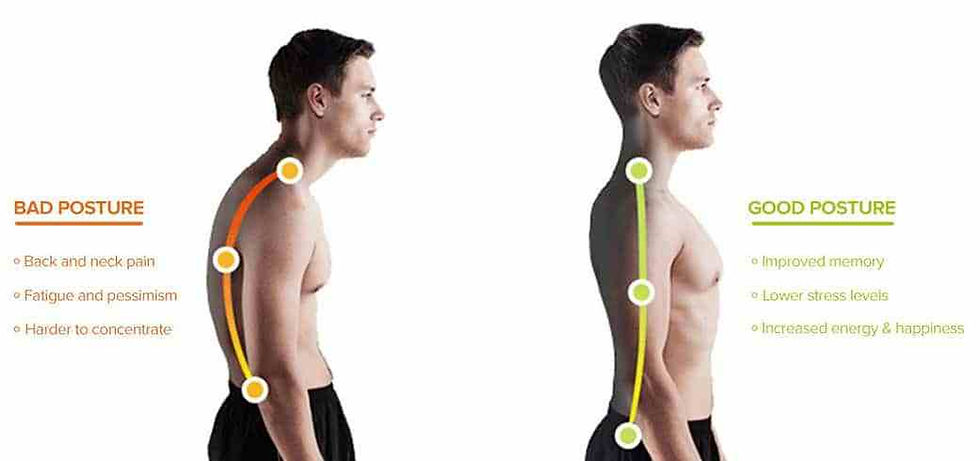4 ways poor posture can impact your life!
- sydneyfamilychiro

- Dec 10, 2022
- 4 min read
Poor posture can result in a number of different pains and problems, the most common including:
Lower back pain
Neck pain/ shoulder pain
Headaches
Increased stress and fatigue
What are the benefits of maintaining good posture?
Creating good posture habits and maintaining good posture throughout the day takes the added pressure off your joints, nerves and muscles. This allows your body to work and function at its optimal ability.
Maintaining good posture helps to reduce and/or relieve neck and lower back pain.
Good posture can help to reduce stress and fatigue. Reducing the impact and stress on your neck allows nerves and muscles to work effectively.
How can poor posture impact your life

Four ways poor posture can impact your life include:
Decreased nervous system function
The nervous system controls everything in our body. It lives within our brain and spine, transporting the messages our brain tells to the rest of our body.
Poor posture can impact our nervous system by slowing down those signals and messages slowing down the response from the body.
Decreased nervous system function can look like many things. Examples include:
Headaches
Muscle tension
Poor gut health
Poor sleep
Decreased movement
Numbness/tingling/pins and needles across the body
And many more
Pain
Poor posture can have a huge impact on what we feel within our bodies. When we have poor posture, it puts added stress and strain on our muscles, nerves, and joints, resulting in pain for people. The most common pain people feel from poor posture is neck, shoulder and lower back pain.
In some more severe cases people can experience ‘slipped discs’ – which in medical terms, is a herniated disc. Discs are essentially cushions for each level of our spine. When these cushions slip, they push outwards and can put pressure on our nerves and cause pain, numbness, tingling, pins and needles, and even electrical shock-like pain.
Decreased blood circulation
Long periods of sitting down allows the heart rate to slow, causing the blood circulation around the body to decrease. Blood plays a crucial role in the function of not only our organs (heart, lungs, liver, kidneys, brain, etc) but for our muscles and overall health. Extended sitting, particularly in a poor or slumped posture can create issues in these regions.
Aging
When people talk about aging, it is known as degeneration through our bodies. Poor posture can speed up the aging process because our body cannot cope with the added pressure. Once the aging process has started, it is hard to stop, but fixing your posture can help to slow it down.
How can you improve your posture?
Tips to help improve your posture include:
Seek help
By seeking out help from a professional (such as a Chiropractor, Physiotherapist or Osteopath) they can help correct your posture and give helpful tips and hints for home and work life.
Regular breaks
Taking breaks from prolonged sedentary behavior helps not only your ability to focus, but also helps increase blood flow.
Prolonged sitting causes a slower heart rate, decreasing the blood flow in the body. The body can become more tired and fatigued when in a prolonged sedentary sitting position, putting more stress on your joints and muscles, leading to a steady decline in posture. If you have a desk job (or another sedentary job), taking a 1-2 minute walk every 45 minutes can help to reset the body, increase blood flow and may help you to refocus when getting back to your desk.
Ergonomic work setup
For those who spend a large portion of their day sitting down (work, studying, etc), having an ergonomic setup can be a crucial help to our seated posture.
Our tips for an ergonomic setup:
Have your screen set up at eye level. This allows your head and neck to remain in a neutral position and not leaning or looking down.
Have an ergonomic work chair that supports your spine’s natural curves and allows for comfort while sitting. You do not want a chair that’s too soft or squishy or allows you to slump down. You want a chair that supports you while sitting upright.
Use a sit-to-stand desk that can be moved and down. These desks are easily adjustable to a height that suits you and allows you to stand up during work, helping to increase blood flow and movement.
Correct lifting posture
Your posture while lifting can have a massive impact on the way our muscles and joints work. When we get into bad habits such as bending forward, not bending our knees, and lifting/pulling while twisting causes excessive stress on the lower back and the spinal discs.
Make sure whenever you are lifting or pulling anything heavy that you support your lower back by contracting your core, bending with your knees, keeping a straight back and completing lifting tasks in a slow and controlled manner.
Exercise
Exercising has many benefits – including for your posture! As we have already discussed, blood flow is really important for your organs, muscles and ligaments. Taking 1-2 fifteen minute brisk walks per day can help reset the. body, flush out any metabolic waste that’s been building up, increase your endorphins and reduce tension in the muscles.
Weight or resistance training can help to strengthen muscles and joints that are generally weak from everyday movements (or lack thereof) and posture.
If you’d like to get your posture assessed, contact us or simply want to know more?....Book a consultation with us and we can kick-start the summer healing process. Click HERE to book your initial consultation with one of our Chiropractors at Sydney Family Chiropractic.
#manualtherapy #sydneyfamilychiro #adjustment #spinalhealth #neckpaintreatment #neckpain #painrelief #summer
Our Chiropractors can provide you with tailored and appropriate care, as well as lifestyle advice to help improve your spinal health and overall wellbeing.





Comments